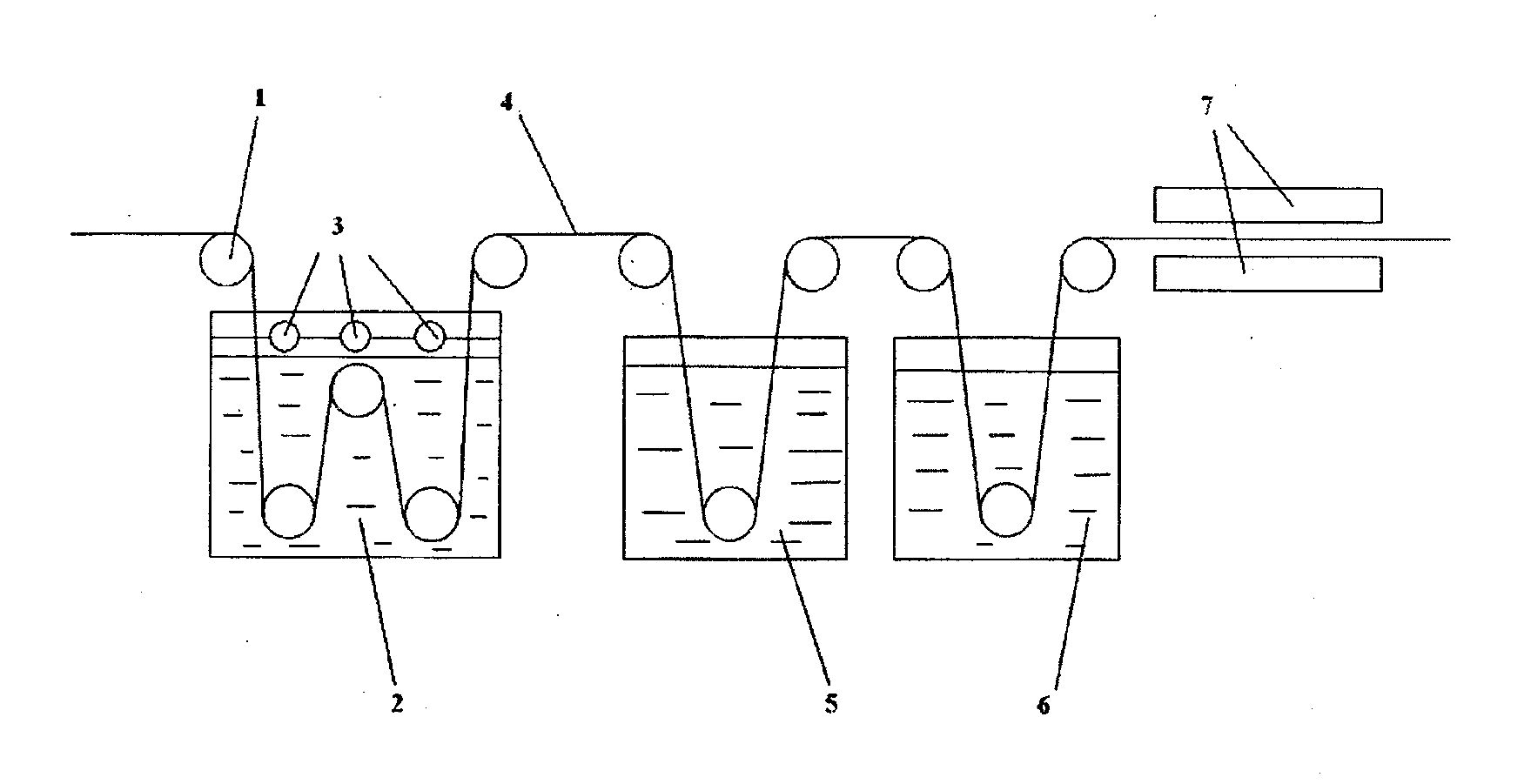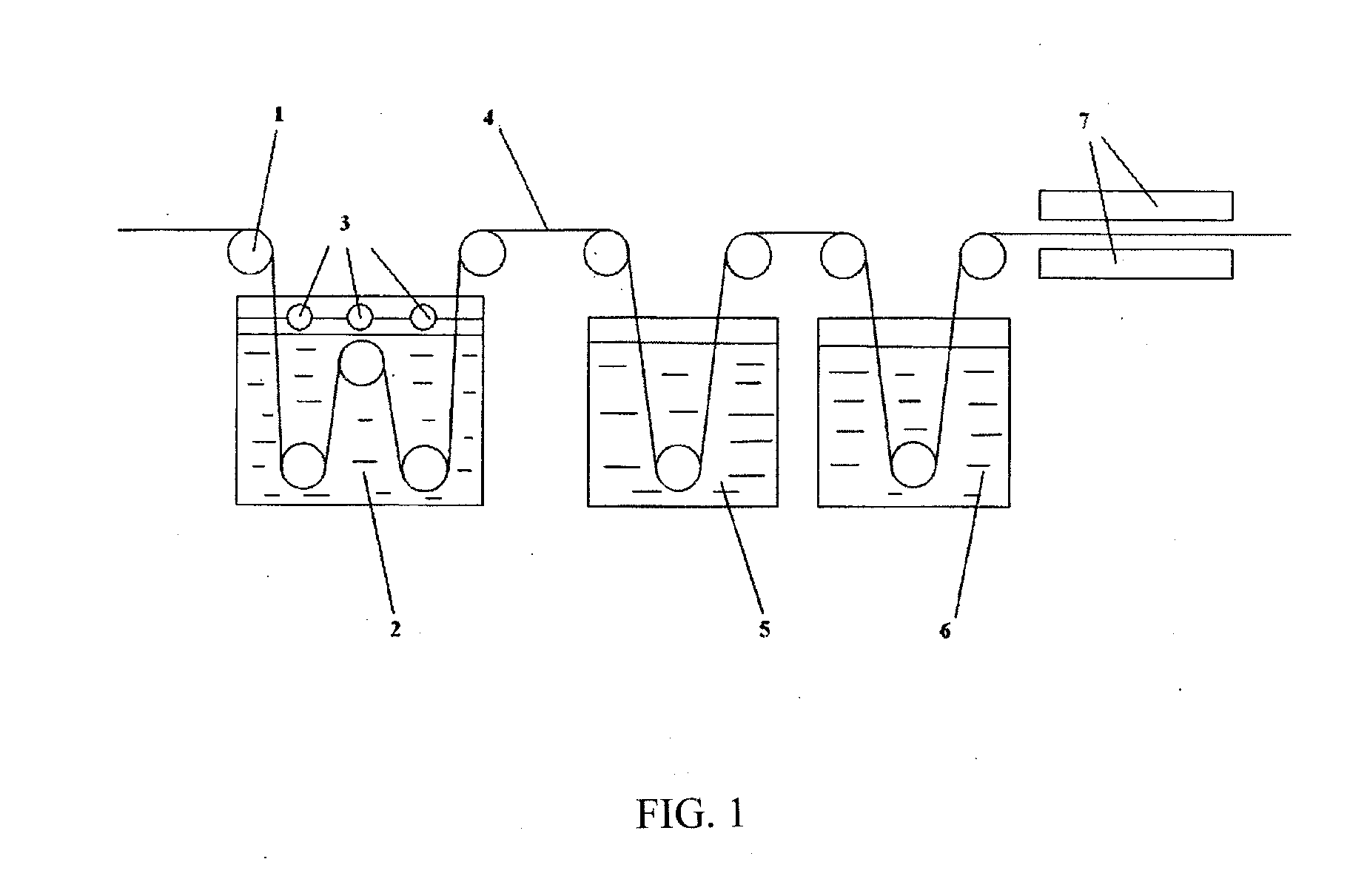Preparation method of optical colorful polyester film using microwave technique
a microwave technology and polyester film technology, applied in the field of optical materials, can solve the problems of inconvenient preparation of films that need to be frequently changed colors, unrealistic process for dyeing few films, high cost, etc., and achieve the effects of reducing solvent and water loss, increasing dye dispersion, and maintaining the stability of dye concentration
- Summary
- Abstract
- Description
- Claims
- Application Information
AI Technical Summary
Benefits of technology
Problems solved by technology
Method used
Image
Examples
example 1
Red Film
[0035]Five parts of ethylene glycol, 0.2 parts of disperse bright red and 0.06 parts of HAC were added into 50 parts of disperse dye suspension with steady water phase, a microwave device with the power of 5 KW was turned on and dyeing was carried out by controlling the temperature of 85° C.; and rinsing was carried out with hot water added with 2% sodium dodecyl benzene sulfonate, then rinsing was carried out with ethanol, drying was carried out at 150° C. for 30 seconds in a drying tunnel, and a vivid red polyester film was obtained.
[0036]The film before and after dyeing was taken to make test using a transmittance testing instrument, and for the transmittance change of the film under visible light with dyeing time change see Table 1.
TABLE 1Transmittance change of film prepared usingmicrowave technique with dyeing time changeDyeing time (s)0103060120Visible light transmittance (%)8865534145
See Table 2 for the visible light transmittance change of the film with time change ...
example 2
Solvent Resistance
[0037]A film was dyed using the formula and microwave technique of Example 1. After dried at 150° C., the dye was fixed in the polyester film and had good solvent resistance. Table 3 shows the transmittance change of the 120-second colored film after soaked for 30 minutes in different solvents.
TABLE 3Solvent resistance of colored filmSoaking byethylsolvent forNomethylethylpetroleum30 minsoakingketonetolueneacetateetheracetoneethanoltetrahydrofuranVisible light4852515350525255transmittance (%)
[0038]After dried at 130-170° C., the dye carrier remained in the film was thoroughly removed, and the films of 10 g were selected to make comparison of the weight before and after dyeing, for the results see Table 4. From the table may find that the dye carrier remained in the film gradually volatilizes with the increase of the drying time and drying temperature. It is to be noted that the weight of the colored film is smaller than that of the original film when the drying tem...
example 3
Yellow Film
[0039]Example 1 was repeated, with the following deference. The 0.2 parts of disperse bright red in the disperse dye suspension with steady water phase in Example 1 was replaced by 0.2 parts of disperse golden yellow. A vivid golden yellow polyester film was obtained according to the same technological conditions.
[0040]The film before and after dyeing was taken to make test using a transmittance testing instrument, and for the visible light transmittance change of the film with dyeing time change see Table 5.
TABLE 5Transmittance of yellow film under different dyeing timesDyeing time (s)0103060120Visible light transmittance (%)8883777470
PUM
| Property | Measurement | Unit |
|---|---|---|
| temperature | aaaaa | aaaaa |
| temperature | aaaaa | aaaaa |
| resistance | aaaaa | aaaaa |
Abstract
Description
Claims
Application Information
 Login to View More
Login to View More - R&D
- Intellectual Property
- Life Sciences
- Materials
- Tech Scout
- Unparalleled Data Quality
- Higher Quality Content
- 60% Fewer Hallucinations
Browse by: Latest US Patents, China's latest patents, Technical Efficacy Thesaurus, Application Domain, Technology Topic, Popular Technical Reports.
© 2025 PatSnap. All rights reserved.Legal|Privacy policy|Modern Slavery Act Transparency Statement|Sitemap|About US| Contact US: help@patsnap.com


